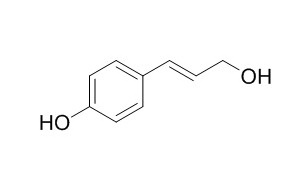p-Coumaryl alcohol
p-Coumaryl alcohol derivatives have antioxidant activity.
Inquire / Order:
manager@chemfaces.com
Technical Inquiries:
service@chemfaces.com
Tel:
+86-27-84237783
Fax:
+86-27-84254680
Address:
1 Building, No. 83, CheCheng Rd., Wuhan Economic and Technological Development Zone, Wuhan, Hubei 430056, PRC
Providing storage is as stated on the product vial and the vial is kept tightly sealed, the product can be stored for up to
24 months(2-8C).
Wherever possible, you should prepare and use solutions on the same day. However, if you need to make up stock solutions in advance, we recommend that you store the solution as aliquots in tightly sealed vials at -20C. Generally, these will be useable for up to two weeks. Before use, and prior to opening the vial we recommend that you allow your product to equilibrate to room temperature for at least 1 hour.
Need more advice on solubility, usage and handling? Please email to: service@chemfaces.com
The packaging of the product may have turned upside down during transportation, resulting in the natural compounds adhering to the neck or cap of the vial. take the vial out of its packaging and gently shake to let the compounds fall to the bottom of the vial. for liquid products, centrifuge at 200-500 RPM to gather the liquid at the bottom of the vial. try to avoid loss or contamination during handling.
Research on Crops.2017, 18(2)
Int J Mol Sci.2022, 23(15):8687.
Biomed Pharmacother.2021, 137:111362.
Molecules.2023, 28(10):4062.
Journal of Physiology & Pathology in Korean Medicine.2018, 32(2): 106-112
Malaysian Journal of Analytical Sciences2023, 27(4):840-848.
SSRN2024, 4937625.
J Cachexia Sarcopenia Muscle.2022, 13(6):3149-3162.
BMC Complement Altern Med.2016, 16:213
Metabolites.2023, 13(6):689.
Related and Featured Products
Microb Cell Fact. 2015 Jun 11;14:79.
Combinatorial optimization of synthetic operons for the microbial production of p-coumaryl alcohol with Escherichia coli.[Pubmed:
26062542]
Microbes are extensively engineered to produce compounds of biotechnological or pharmaceutical interest. However, functional integration of synthetic pathways into the respective host cell metabolism and optimization of heterologous gene expression for achieving high product titers is still a challenging task. In this manuscript, we describe the optimization of a tetracistronic operon for the microbial production of the plant-derived phenylpropanoid p-Coumaryl alcohol in Escherichia coli.
METHODS AND RESULTS:
Basis for the construction of a p-Coumaryl alcohol producing strain was the development of Operon-PLICing as method for the rapid combinatorial assembly of synthetic operons. This method is based on the chemical cleavage reaction of phosphorothioate bonds in an iodine/ethanol solution to generate complementary, single-stranded overhangs and subsequent hybridization of multiple DNA-fragments. Furthermore, during the assembly of these DNA-fragments, Operon-PLICing offers the opportunity for balancing gene expression of all pathway genes on the level of translation for maximizing product titers by varying the spacing between the Shine-Dalgarno sequence and START codon. With Operon-PLICing, 81 different clones, each one carrying a different p-Coumaryl alcohol operon, were individually constructed and screened for p-Coumaryl alcohol formation within a few days. The absolute product titer of the best five variants ranged from 48 to 52 mg/L p-Coumaryl alcohol without any further optimization of growth and production conditions.
CONCLUSIONS:
Operon-PLICing is sequence-independent and thus does not require any specific recognition or target sequences for enzymatic activities since all hybridization sites can be arbitrarily selected. In fact, after PCR-amplification, no endonucleases or ligases, frequently used in other methods, are needed. The modularity, simplicity and robustness of Operon-PLICing would be perfectly suited for an automation of cloning in the microtiter plate format.
Curr Biol. 2012 Jul 10;22(13):1207-12.
AtABCG29 is a monolignol transporter involved in lignin biosynthesis.[Pubmed:
22704988]
Lignin is the defining constituent of wood and the second most abundant natural polymer on earth. Lignin is produced by the oxidative coupling of three monolignols: p-Coumaryl alcohol, coniferyl alcohol, and sinapyl alcohol. Monolignols are synthesized via the phenylpropanoid pathway and eventually polymerized in the cell wall by peroxidases and laccases. However, the mechanism whereby monolignols are transported from the cytosol to the cell wall has remained elusive.
METHODS AND RESULTS:
Here we report the discovery that AtABCG29, an ATP-binding cassette transporter, acts as a p-Coumaryl alcohol transporter. Expression of AtABCG29 promoter-driven reporter genes and a Citrine-AtABCG29 fusion construct revealed that AtABCG29 is targeted to the plasma membrane of the root endodermis and vascular tissue. Moreover, yeasts expressing AtABCG29 exhibited an increased tolerance to p-Coumaryl alcohol by excreting this monolignol. Vesicles isolated from yeasts expressing AtABCG29 exhibited a p-Coumaryl alcohol transport activity.
CONCLUSIONS:
Loss-of-function Arabidopsis mutants contained less lignin subunits and were more sensitive to p-Coumaryl alcohol. Changes in secondary metabolite profiles in abcg29 underline the importance of regulating p-Coumaryl alcohol levels in the cytosol. This is the first identification of a monolignol transporter, closing a crucial gap in our understanding of lignin biosynthesis, which could open new directions for lignin engineering.



